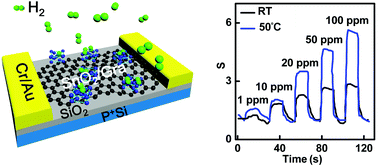Hydrogen gas sensor based on metal oxide nanoparticles decorated graphene transistor†
Abstract
In this work, in order to enhance the performance of graphene gas sensors, graphene and metal oxide nanoparticles (NPs) are combined to be utilized for high selectivity and fast response gas detection. Whether at the relatively optimal temperature or even room temperature, our gas sensors based on graphene transistors, decorated with SnO2 NPs, exhibit fast response and short recovery times (∼1 seconds) at 50 °C when the hydrogen concentration is 100 ppm. Specifically, X-ray photoelectron spectroscopy and conductive atomic force microscopy are employed to explore the interface properties between graphene and SnO2 NPs. Through the complimentary characterization, a mechanism based on charge transfer and band alignment is elucidated to explain the physical originality of these graphene gas sensors: high carrier mobility of graphene and small energy barrier between graphene and SnO2 NPs have ensured a fast response and a high sensitivity and selectivity of the devices. Generally, these gas sensors will facilitate the rapid development of next-generation hydrogen gas detection.


 Please wait while we load your content...
Please wait while we load your content...